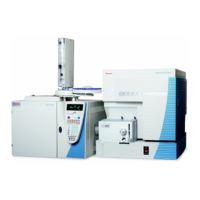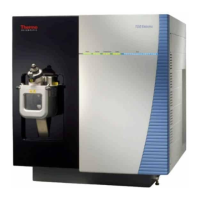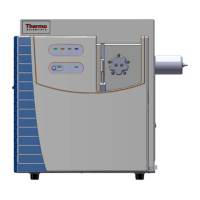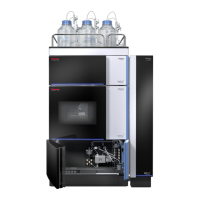2
Functional Description
Mass Spectrometer
Thermo Scientific TSQ Series Hardware Manual 25
Figure 16. Tube lens of the TSQ Quantum Access, TSQ Quantum Access MAX, or TSQ Quantum
Ultra mass spectrometer
The TSQ Vantage mass spectrometer uses an S-lens and exit lens rather than a tube lens and
skimmer. The S-lens is an ion transmission device consisting of progressively-spaced,
stainless-steel electrodes. See Figure 17. A 650 kHz rf voltage is applied to the electrodes, and
adjacent electrodes have voltages of opposite phase. As the rf amplitude increases, ions of
progressively higher mass-to-charge ratios pass through to the exit lens. During the tune
procedure, the TSQ Vantage mass spectrometer determines the mass-dependent rf amplitudes
for optimum transmission of ions through the lens. The maximum amplitude is 300 V
peak-to-peak.
Figure 17. S-lens of the TSQ Vantage mass spectrometer
Ions from the tube lens or S-lens pass through the skimmer (Figure 18) or exit lens
(Figure 19) and move toward the Q00 rf lens. The skimmer and exit lens act as a vacuum
baffle between the higher pressure ion source interface region (at 1.5 Torr) and the lower
pressure Q00 ion optics region (at 50 mTorr) of the vacuum manifold. The apertures of the
skimmer and exit lens are offset with respect to the bore of the ion transfer tube. This
arrangement reduces the number of large, charged particles that pass through the skimmer or
exit lens into the mass analyzer, which reduces detector noise. The tube lens and skimmer, or
the S-lens and exit lens, mount to the ion source interface cage.

